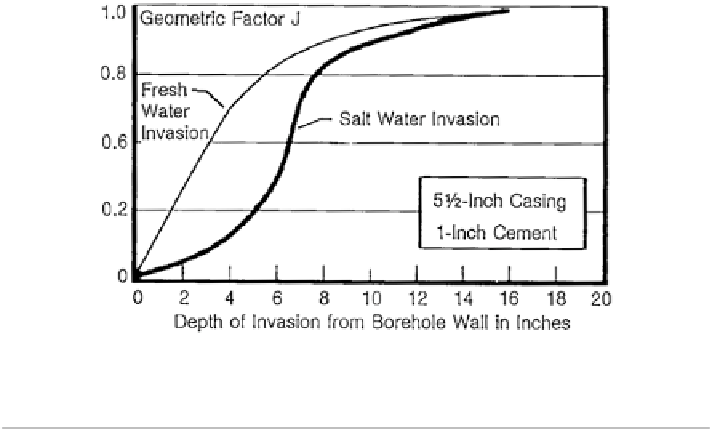Environmental Engineering Reference
In-Depth Information
Depth of Investigation
Another item of interest is the depth of investigation of the pulsed neutron tool. As
with most radioactivity measurements, there is no fixed depth of investigation.
Rather, a geometric factor describes what percentage of the total signal comes from
what radial distance from the borehole wall. Figure
11.32
shows the response of the
TDT-K in 5½″ casing with a 1-in. cement sheath. Note that “depth of investigation”
is somewhat deeper if salt water has invaded the formation. At all events, the major-
ity of the signal comes from within one foot of the borehole wall.
Fig. 11.32
Depth of investigation of typical pulsed neutron measurement
Inelastic Gamma Ray Logging
Neutron logging is continually evolving to reap evermore information about the
formations surrounding the tools. Modern versions are used for what is termed
elemental spectral analysis. This takes advantage of what are known as inelastic
collisions between fast neutrons and the nuclei of the atoms that make up the
chemical compounds found in the formation surrounding the cased borehole.
When a fast neutron strikes a magnesium nucleus, for example, the nucleus is
excited to a higher energy level and then returns to a lower energy level by emitting
a gamma ray of characteristic energy. It turns out that the energy of the gamma ray
emitted as a result of this inelastic collision can be classified as having come from
a magnesium nucleus. Figure
11.33
gives a schematic of a generic neutron logging
tool. Note that two annular volumes are depicted surrounding the tool. In the
immediate vicinity of the tool is the region where the inelastic interactions take
place. Further out radially note that there is a second annular volume of the for-
mation from which gamma rays resulting from capture of thermalized neutrons
emanate.

Search WWH ::

Custom Search